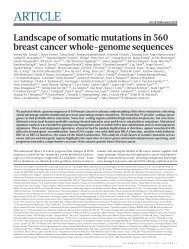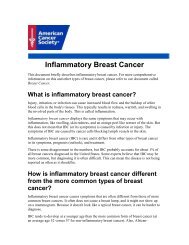IBC -what we know and what we need to learn
You also want an ePaper? Increase the reach of your titles
YUMPU automatically turns print PDFs into web optimized ePapers that Google loves.
894 Inflamma<strong>to</strong>ry Breast Cancer<br />
Figure 1. Workup for inflamma<strong>to</strong>ry breast cancer.<br />
sample sizes <strong>and</strong> the molecular heterogeneity of <strong>IBC</strong>, none of<br />
these findings can be considered conclusive [15]. An effort is<br />
underway <strong>to</strong> combine microarray data <strong>to</strong> define the molecular<br />
characteristics of <strong>IBC</strong>. Other studies revealed that the frequency<br />
of hormone recep<strong>to</strong>r positivity is lo<strong>we</strong>r in <strong>IBC</strong> than in<br />
non-<strong>IBC</strong>, that patients with estrogen recep<strong>to</strong>r–negative <strong>IBC</strong><br />
have a poorer prognosis than patients with estrogen recep<strong>to</strong>r–<br />
positive <strong>IBC</strong> [1, 16], <strong>and</strong> that the molecular subtypes of <strong>IBC</strong><br />
are similar <strong>to</strong> those of non-<strong>IBC</strong> [17]. These molecular subtypes<br />
may have important clinical <strong>and</strong> molecular differences. Thus,<br />
future studies involving <strong>IBC</strong> should consider the various molecular<br />
<strong>and</strong> clinical subtypes separately [18].<br />
There is a <strong>need</strong> for more detailed molecular dissection of<br />
<strong>IBC</strong> through microdissection <strong>and</strong> comparing the genome in<br />
tumor versus nontumor areas, tumor emboli versus the dominant<br />
tumor mass, <strong>and</strong> skin versus the primary tumor. Microarray<br />
investigations of skin lesions may produce more<br />
significant results than his<strong>to</strong>logical examinations. Because<br />
breast skin changes are one of the most prominent clinical<br />
features of <strong>IBC</strong>, investigations focused on skin lesions seem<br />
worthwhile. Furthermore, because <strong>IBC</strong> cells (like stem<br />
cells) are very aggressive, there should be more investigation<br />
of whether or not <strong>IBC</strong> cells have stem cell characteristics<br />
[19, 20].<br />
HOW SHOULD WE USE IMAGING FOR <strong>IBC</strong>?<br />
The challenge in imaging women with suspected or confirmed<br />
<strong>IBC</strong> is <strong>to</strong> identify a primary breast tumor <strong>to</strong> facilitate<br />
image-guided biopsy so that the recep<strong>to</strong>r <strong>and</strong> biomarker status<br />
can be established <strong>and</strong> appropriate neoadjuvant chemotherapy<br />
can be initiated. It is <strong>we</strong>ll established that 20%–30%<br />
of women with newly diagnosed <strong>IBC</strong> have distant metastasis<br />
at the time of diagnosis; imaging may also be useful in<br />
identifying such distant metastases [21]. Another use of imaging<br />
in women with <strong>IBC</strong> is <strong>to</strong> evaluate the response <strong>to</strong> therapy<br />
[7].<br />
Significant advances in imaging techniques, including digital<br />
mammography, high-resolution ultrasonography with<br />
Doppler capabilities, magnetic resonance imaging (MRI), <strong>and</strong><br />
positron emission <strong>to</strong>mography–computed <strong>to</strong>mography (PET–<br />
CT), have improved the diagnosis <strong>and</strong> staging of <strong>IBC</strong>. CT <strong>and</strong><br />
whole-body scintigraphy play a role in the staging of <strong>IBC</strong>, as<br />
they do in the staging of non-<strong>IBC</strong>.<br />
Mammography<br />
As in other types of breast cancer, mammography in women<br />
with <strong>IBC</strong> may reveal a mass, architectural dis<strong>to</strong>rtion, or calcifications.<br />
Skin thickening <strong>and</strong> trabecular dis<strong>to</strong>rtion are seen in<br />
80% of patients with <strong>IBC</strong>; these findings may suggest the diagnosis<br />
of <strong>IBC</strong> but are nonspecific [22, 23]. In women with<br />
<strong>IBC</strong>, the rate of identification of a primary tumor on mammography<br />
is very low. A retrospective review in patients with confirmed<br />
<strong>IBC</strong> demonstrated that a primary tumor was found in<br />
only 15% of cases; the most common radiologic sign was trabecular<br />
dis<strong>to</strong>rtion [23]. The better contrast resolution of digital<br />
mammography allows visualization of skin thickening, trabecular<br />
<strong>and</strong> stromal thickening, <strong>and</strong> diffuse increased breast density—findings<br />
that are frequently associated with <strong>IBC</strong> [22, 23].<br />
A focal mass lesion or a group of suspicious calcifications is<br />
less common in <strong>IBC</strong> than in non-<strong>IBC</strong> [23]. Therefore, it is recommended<br />
that women with suspected <strong>IBC</strong> undergo bilateral<br />
mammography, which will provide screening of the contralateral<br />
breast.<br />
Downloaded from http://theoncologist.alphamedpress.org/ at UNIV OF TX MD ANDERSON CANCER CT on Oc<strong>to</strong>ber 31, 2015








